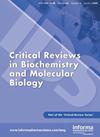运动训练与骨骼肌线粒体蛋白质的变化:从印迹到 "omics"。
IF 6.4
2区 生物学
Q1 BIOCHEMISTRY & MOLECULAR BIOLOGY
Critical Reviews in Biochemistry and Molecular Biology
Pub Date : 2024-09-17
DOI:10.1080/10409238.2024.2383408
引用次数: 0
摘要
线粒体是一种重要的膜封闭细胞器,由 1100 多种不同的蛋白质组成,可发挥对维持新陈代谢至关重要的多种功能。新陈代谢旺盛的组织,如骨骼肌,线粒体含量很高,并随着运动训练而增加。经典的 Western 印迹技术显示,训练诱导了所研究的相对较少的线粒体蛋白质(占 MitoCarta 中超过 1100 种蛋白质的 5%)的增加,其中一些变化取决于训练刺激。蛋白质组学方法还发现了数百种对运动训练有反应的线粒体蛋白质。然而,在已发表的人体训练研究中,所发现的线粒体蛋白质几乎没有交叉,这令人惊讶。这表明,要想更好地了解训练诱导的线粒体蛋白质变化与新陈代谢之间的联系,未来的研究不仅需要最大限度地检测蛋白质,还需要采用能提高所观察到的蛋白质丰度变化可靠性的方法。本文章由计算机程序翻译,如有差异,请以英文原文为准。
Exercise training and changes in skeletal muscle mitochondrial proteins: from blots to "omics".
Mitochondria are essential, membrane-enclosed organelles that consist of ∼1100 different proteins, which allow for many diverse functions critical to maintaining metabolism. Highly metabolic tissues, such as skeletal muscle, have a high mitochondrial content that increases with exercise training. The classic western blot technique has revealed training-induced increases in the relatively small number of individual mitochondrial proteins studied (∼5% of the >1100 proteins in MitoCarta), with some of these changes dependent on the training stimulus. Proteomic approaches have identified hundreds of additional mitochondrial proteins that respond to exercise training. There is, however, surprisingly little crossover in the mitochondrial proteins identified in the published human training studies. This suggests that to better understand the link between training-induced changes in mitochondrial proteins and metabolism, future studies need to move beyond maximizing protein detection to adopting methods that will increase the reliability of the changes in protein abundance observed.
求助全文
通过发布文献求助,成功后即可免费获取论文全文。
去求助
来源期刊
CiteScore
14.90
自引率
0.00%
发文量
6
期刊介绍:
As the discipline of biochemistry and molecular biology have greatly advanced in the last quarter century, significant contributions have been made towards the advancement of general medicine, genetics, immunology, developmental biology, and biophysics. Investigators in a wide range of disciplines increasingly require an appreciation of the significance of current biochemical and molecular biology advances while, members of the biochemical and molecular biology community itself seek concise information on advances in areas remote from their own specialties.
Critical Reviews in Biochemistry and Molecular Biology believes that well-written review articles prove an effective device for the integration and meaningful comprehension of vast, often contradictory, literature. Review articles also provide an opportunity for creative scholarship by synthesizing known facts, fruitful hypotheses, and new concepts. Accordingly, Critical Reviews in Biochemistry and Molecular Biology publishes high-quality reviews that organize, evaluate, and present the current status of high-impact, current issues in the area of biochemistry and molecular biology.
Topics are selected on the advice of an advisory board of outstanding scientists, who also suggest authors of special competence. The topics chosen are sufficiently broad to interest a wide audience of readers, yet focused enough to be within the competence of a single author. Authors are chosen based on their activity in the field and their proven ability to produce a well-written publication.

 求助内容:
求助内容: 应助结果提醒方式:
应助结果提醒方式:


